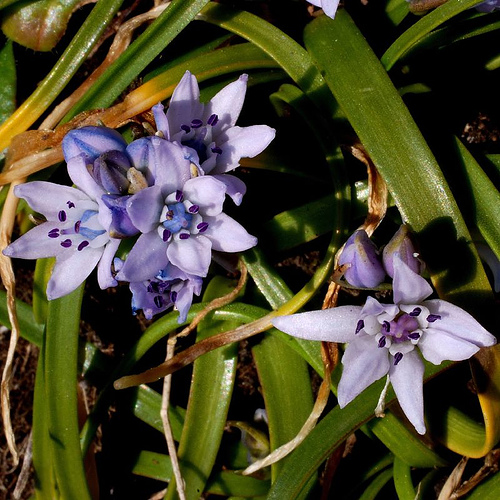- Scilla verna
Taxobox | name = Spring squill

image_width = 240px
regnum =Plant ae
divisio = Magnoliophyta
classis =Liliopsida
ordo =Asparagales
familia =Hyacinthaceae
genus = "Scilla "
species = "S. verna"
binomial = "Scilla verna"
binomial_authority = Huds."Scilla verna", commonly known as spring squill, is a
flowering plant native toWestern Europe . It belongs to the squillgenus "Scilla " in theHyacinthaceae family. Its star-like blueflowers are produced during the spring.It is a small plant, usually reaching 5-15 centimetres in height. It is perennial and grows from a
bulb which is 10-15 millimetres across andovoid in shape. Two to seven leaves grow from the base of the plant; they are long and narrow, measuring 3-20 cm by 2-5 mm. The flowers grow in a dense cluster of two to twelve at the top of the upright stem. They are scentless and have six violet-bluetepal s, 5-8 mm long. Each flower has a 5-15 mm long, bluishbract at the base. Theseed s are ovoid and black. Thediploid number ofchromosome s is 20 or 22.The plant occurs from
Portugal north throughSpain ,France ,Great Britain (particularly the west coast) andIreland (mainly along the east coast), reaching as far as theFaroe Islands andNorway . It is found in short dry grassy areas, usually near the sea. It is one of the key components of the H7 plant community in theBritish National Vegetation Classification system. It was chosen as the county flower forCounty Down inNorthern Ireland after a public vote organised by the charityPlantlife in 2002.References
*Stace, Clive A. (1997) "New Flora of the British Isles". Cambridge University Press.
*Tutin, T. G. "et al." (1980) "Flora Europaea", Volume 5. Cambridge University Press.External links
* [http://www.bsbimaps.org.uk/atlas/map_page.php?spid=1857.0&sppname=Scilla+verna&commname=Spring+Squill Distribution of "Scilla verna" in Britain and Ireland]
Wikimedia Foundation. 2010.
